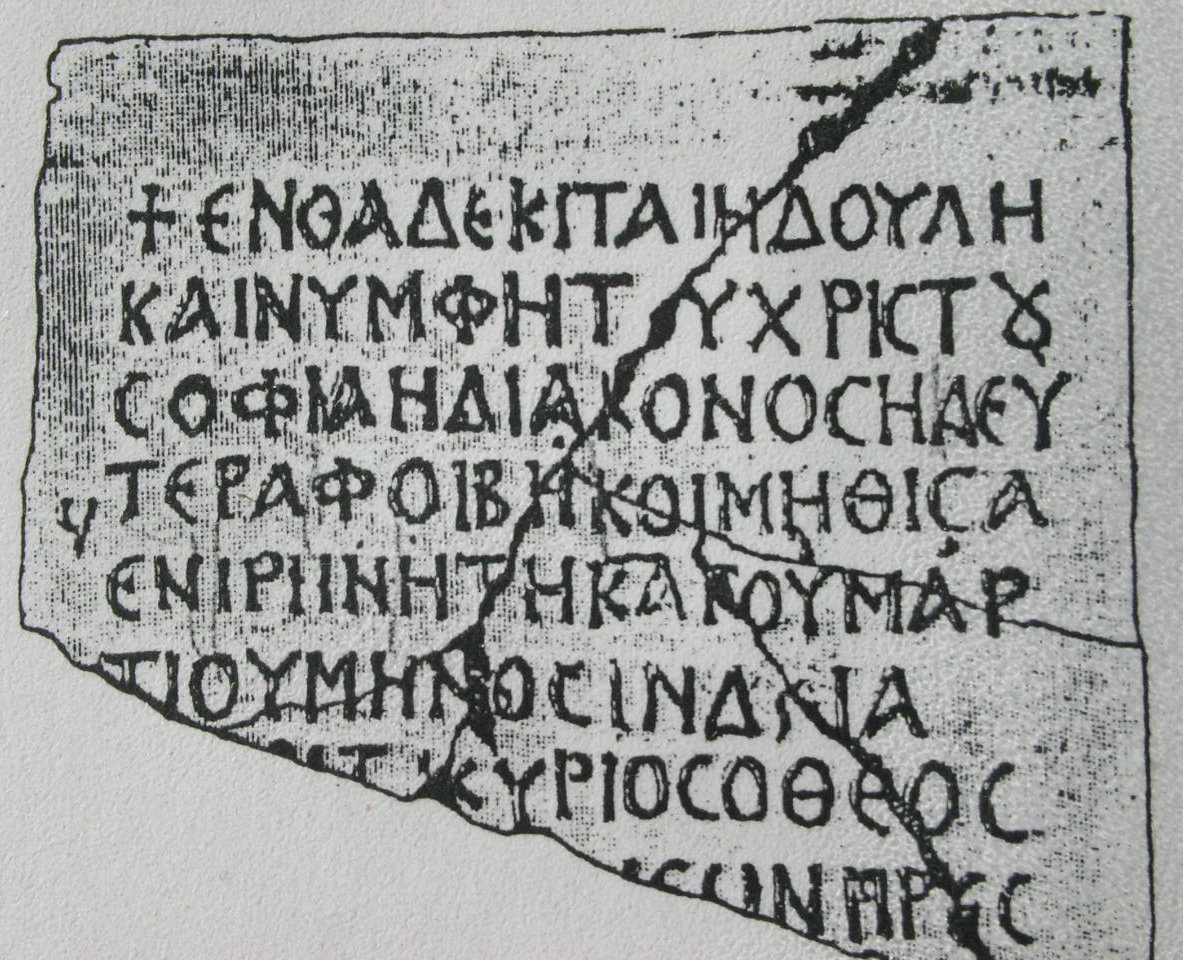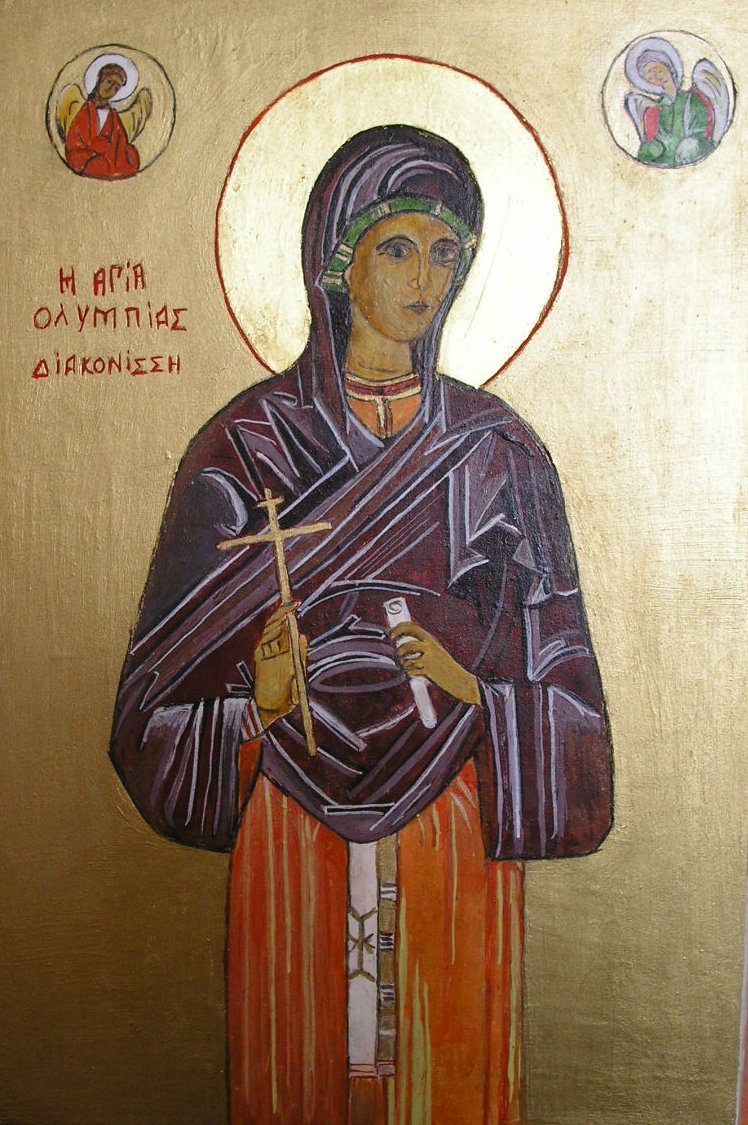It is well-known nowadays , thanks to the
works of many historians, archeologists and liturgists. (You can read it in
details in my book.). If the scriptural, archeological and institutional data
are rather precise, their theological interpretation however is difficult : it
varies with the authors.
The most ancient track of a female
diaconate is found in the letter to Romans., chp 16, verse 1. "I
recommend to you Phoebe, our sister, deaconess in the
Her tasks were charitable : welcoming
and assisting the christians coming from Asia and ,
Cenchrées being the port of Corinth, turned toward
the East. She maybe welcome as well in her house the meetings of the rising Church : indeed
liturgical assemblies were held at that time
in private houses. If we can't greet Phoebe as the first deaconess- the
institution of deaconesses will be described
"It's no mean feat to be called Paul's
sister", St John Chrysostome, the famous archibishop of Constantinople
will say in the V° century ; he was so attached to the deaconesses of his
diocese., but we 'll see it later.
About chapter 3 of the first to Timothee, he is
absolutely clear : "Women likewise…The apostle means deaconesses. Some
people think that it is about women in general. But it is not that. It would
be nonsense to insert at that point something about women in
general. It actually deals with those who have the dignity of
deaconesses."
Between the apostolic time and the
flourishing period when deaconesses will be blossom- between IV° and X°
century-the birth certificate of this institution appears.
In the Didascalie of the Apostles, a syriac
document from the second century, the legislator advised the bishops to chose
women by the side of male deacons. He calls them female deacons or deaconesses.
They have to take part to women baptisms, evangelize them and visit them at
home if they are ill..From the IV° century on, deaconesses organized and developped throughout Mediterranean bassin.

This map shows that the women's presence is attested throughout Asia Minor (Modern
Turkey) Greece,Palestine and the Persian Empire;
official documents, conciliar acts, funerary stelas, literary and theological
writings. The Fathers of the Church talk about them as the bishops'
correspondents and friends.

Deaconess Sophie's stela
This tombstone is in City on Jerusalem on the mount of Olives.
The inscription dating undoubtely from VI° century is
written in Greek : "Here lies, the Christ's servant and virgin, Sophie,
the deaconess, the other Phoebee, aslept in peace on the twenty first day of
march."
The Apostolic Constitutions, a huge liturgical and canonical compilation,
had encouraged the development of this
feminine ministry in the middle IV° century : it presents with a precise
codification of the status of deacon and deaconess.
One of the deaconess' main task
remains the assistance of women during their baptism by immersion,
evangelization and care at home.They welcome women in eucharistic assemblies,
attend to the right order of the assembly. They act as a mediator between women
and the male hierarchy and carry messages outside the city.
They are part of the clergy : just like the clerks, they take part in the handing out of eulogias.(Bread
too many given for the Eucharistic which were not consecrated.) They are protected and even paid by the emperors.
They find their place, like deacons, at Saint Sophie, the Constantinople Cathedral.
Beside, they got an ordination (Some
say benediction) during the eucharistic celebration, with appending of the
hands and solemn prayer by the bishop, in the presence of the presbyterium.
According to the prestigious ritual of byzantine deaconesses' ordination in the
VIII° century, the ceremony was the symetric as the deacons' one.
Nevertheless, we can notice two differences between male and female ordination.:
* A deaconess receive the stole like a
deacon but she wears it around her neck
under her veil with the two tails brought at the front.(See the several
illustration.)
* Moreover, during the ordination, a deacon leans
his forehead against the altar but a deaconess doesn't as she won't have access
to the presbyterate.
At that time, the most famous deaconess is Olympias, Saint John
Chrysostome' s constant friend when he was persecuted . We kept the latter's
very moving correspondence with her.


Icons of saint Olympias and saint John Chrysostome facing eachother by the author.
The icon of saint Olympias was realised from
the one in Patmos. She 's wearing the
"maforion" the large enveloping veil, the diaconal stole with the two
tails brought on the front on a long dress.
That of Saint John Chrysostome is
a russian icon from the second part of the XVI° century. He is dressed in the
traditional bishop dress for those days.
Saint Olympias had founded a convent of 250 deaconesses in Constantinople ,
of which she was the abbess. Olympias had created hospitals in which she cured
patients. She catechized and baptized women.
She is celebrated both in the catholic and
orthodox calendars. Among the holy deaconesses celebrated in the orthodox
calendar are as well saint Phoebee, saint Melanie the young who, by the way,
was roman like saint Dominka, saint Theosobia, saint Gregoire de Nysse's wife,
saint Macrina, sister of the latter, and so many others. They had an important
spiritual influence.
Oriental churches let an original
institution which was flourishing for many centuries collapse. Reasons for that
are numerous. The ritual of baptism by immersion which , for decency reasons,
made the presence of deaconesses ,essential ,disappeared. The deaconess becomes
a religious figure. Deacons no longer fulfill their function of servant for the
poor and the diaconate specificity disappears. The orthodox theology is
declining as it has become imprisoned by the West which is opposed to feminine
ministry.
Then, from XII° to XIV°century there
is a return to the old myth of female impurety among byzantine canonists,
which make the woman unsuited to any ministry.
At last the influence of Islam which more than the Christian Orient , locked
women at home had made it.
In the end, were these prestigious diaconesses ordained ? Here is
the cardinal Congar's point of view : "This is a wrong question. I
think that there is some misunderstanding aboout the notion. In the ancient
Church, "order", "ordo", "ordinare" meant to
establish somebody in a
certain "order" in the Church.There is no question about "is it the
Order sacrament ? ".
We would say certainly today if we would consider
things this way. But the elders did not work like that.The only question was to
be established in an original "ordo", that of the female diaconate.
Ordination was undoubtedly the same as for deacons, with the same text, at the
same place, which is very important unlike minor orders. So, if we wanted to
reason with the present categories, we would say that it is the Order
sacrament, as well as for deacons…I 'd be favourable to the restoration , to
the institution of a female diaconate but it would be, actually, the creation
of an order, because, by now, women do much more than what ancient deaconesses
did. It is quite normal considering that didn't do what was needed in a
civilization where women were held apart and couldn't have a hold on men or approach
the altare"'(Except from the interview, father Congar kindly gave me.)
The Latin Church never met the equivalent of what the Orient
experienced : she dreads heresies from the Orient and especially the influence
of some sects in which women were presiding over the Eucharistic.
Gallic councils often talk about deaconesses but only to punish and
warn. Nevertheless, saint Radegonde , king Colthaire I°'s wife, demanded from
the bishop of Noyon that he made her deaconess. But there was no question of an
ordination., rather a blessing. She founded a monastery.renowned
Saint Geneviéve, another well known character among the Gaul, patron saint of
Parish : she was not a deaconess but had received the consecration from the
Virgins, a solemn ceremony which was practised since the second half of the
IV°century in the Roman Church.
Deaconesses can be founded in central and southern Italy as deacons'
wives and most ot time as abbesses in monasteries.They are still given the
stole, the ring and the veil, according to a specificlc ritual which is neither
an abbey consecration nor the virgins consecration. Most of the time, their
duty simply is the girls' education in the schools adjoining monasteries. This
is the XI° century, which, as in Orient, met the deaconess decline.
Beyond, it is question of historical survivals : some benedictines nuns are still wearing the
stole for liturgical acts.
